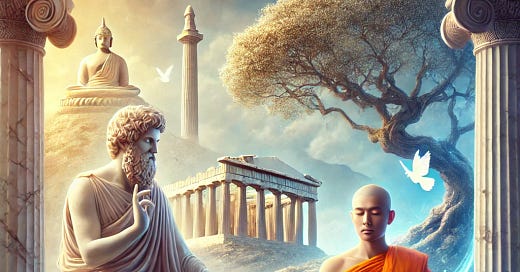TheGentleLaw Community
The philosophical traditions of ancient Greece and Buddhism, though emerging in distinct historical and cultural contexts, share profound reflections on human flourishing, knowledge, and detachment. This article explores seven significant Greek philosophical terms—eudaimonia, ataraxia, acataleptic, diaphora, epoché, pragmata, and asuggamata—through a Buddhist lens, drawing parallels with key Buddhist concepts and examining their similarities and divergences. By delving deeper into these comparisons, we can uncover how these traditions approached the challenges of human existence and the quest for ultimate truth.
Eudaimonia (εὐδαιμονία) and Nirvana (निर्वाण)
Eudaimonia, commonly translated as "flourishing" or "well-being," is the ultimate goal in Aristotelian and Stoic philosophy. Unlike transient pleasure (hēdonē), eudaimonia is a state of living in accordance with virtue (aretē). Aristotle argued that achieving eudaimonia requires rational activity and the cultivation of moral virtues, while the Stoics emphasized the alignment with nature and reason as the highest good.
This resonates with the Buddhist notion of nirvana, the cessation of suffering and the highest state of liberation. Unlike eudaimonia, which operates within an ethical and rational framework within the world, nirvana transcends worldly existence, representing an ultimate release from the cycle of birth and death (samsara). Both, however, emphasize a life guided by wisdom and moral integrity, though Buddhism places greater emphasis on overcoming attachment and delusion.
Ataraxia (ἀταραξία) and Upekkhā (उपेक्षा)
Epicurean and Stoic philosophy advocate ataraxia, a state of serene equanimity, free from disturbance and distress. Epicurus viewed ataraxia as freedom from unnecessary desires and fears, while the Stoics saw it as a product of rational detachment from external events.
Similarly, upekkhā (equanimity) in Buddhism is one of the four sublime states (brahmavihāra) and represents an unshakable peace of mind. However, whereas the Greek tradition often ties ataraxia to rational detachment and measured pleasure, upekkhā in Buddhism is deeply connected to wisdom (paññā) and compassionate engagement with the suffering of others. The Buddhist ideal of equanimity is not merely a passive state but an active balance of mental composure amid life’s changing conditions.
Acataleptic (ἀκατάληπτος) and Anicca (अनिच्चा)
Skeptic philosophers argued that nothing could be fully comprehended, coining the term acataleptic, meaning "incomprehensible" or "ungraspable." Pyrrhonian Skeptics suspended judgment to avoid error, believing that certainty was unattainable. This concept aligns with the Buddhist teaching of anicca (impermanence), which asserts that all phenomena are in constant flux and thus cannot be grasped as permanent truths.
While Pyrrhonian skepticism leads to a state of intellectual suspension (epoché), Buddhism moves beyond doubt to cultivate experiential wisdom (vipassanā), which recognizes impermanence but also provides a structured path to liberation. The Buddhist approach acknowledges the limitations of conceptual knowledge but encourages direct insight (paññā) as a means to transcend suffering.
Keep reading with a 7-day free trial
Subscribe to The Gentle Law to keep reading this post and get 7 days of free access to the full post archives.





